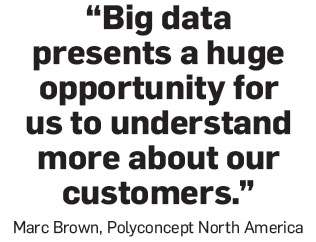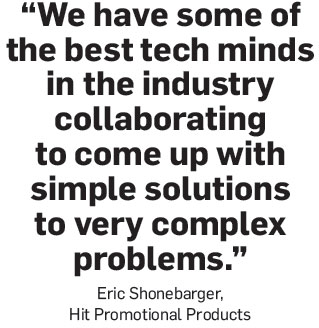Awards April 27, 2017
Utilizing Big Data in the Ad Specialty Industry
A glimpse at how advanced analytics are being used by promotional products companies – and how information, not just ideas, will shape the market’s future.
Did you hear about the time Target knew one of its teenage customers was pregnant before her father did?

No, that’s not the beginning of a tasteless joke. It’s the start of a real-world tale that could only happen in the era of big data.
After Target started sending coupons to a Minnesota man’s daughter for baby clothes and cribs, he stormed into one of the retailer’s stores outside Minneapolis and lambasted the manager, demanding to know if Target was encouraging his high schooler to become pregnant. The manager apologized, but when he called again a few days later, it was the father’s turn to say sorry for his behavior.
The young woman was, in fact, pregnant. How did Target know this?
Big data.
Led by data exec Andrew Pole, Target analyzed huge volumes of purchasing data and developed a formula that enabled the retailer to assign customers a “pregnancy prediction” score. Based on purchasing related to about 25 products commonly bought by pregnant consumers, the formula was so accurate that it could even estimate due dates within a tight timeframe. This let Target market baby-related offerings at precise stages of a woman’s pregnancy when she was most likely to buy them – explaining why the Minnesota teen received the coupon mailings. The New York Times Magazine, which originally reported the story, says Target’s mom and baby sales soared thanks to an advertising campaign driven by the big data-backed formula.
Of course, Target isn’t the only company leveraging big data. Whether it’s to spur efficiency, build better products, enhance service or predict buyer behavior to generate greater sales, businesses in many industries are increasingly relying on big data to gain competitive advantages. As the cyber age rapidly advances, tech-savvy firms in the promotional products industry are getting in on the big data action, too. And while use of big data in the promo niche is in its early stages, industry CTOs are excited about the potential business-building applications. “Big data presents a huge opportunity for us to understand more about our customers, to help them understand more about their customers, and to develop and deliver better offerings in a more efficient manner,” says Marc Brown, chief information officer of Top 40 supplier Polyconcept North America, parent company of Leed’s (asi/66887), Trimark (asi/92121) and others.
In what follows, Counselor delves into how some distributors and suppliers are utilizing big data, and provides insight into how the number-crunching analytics are affecting the industry.
Big Data Distributors
To have a coherent discussion on big data, information technology leaders in the promo products industry say it’s important to start from a shared understanding of what the term means. Generally, industry IT execs Counselor interviewed favor a definition offered by research firm Gartner: “Big data is high-volume, high-velocity and/or high-variety information assets that demand cost-effective, innovative forms of information processing that enable enhanced insight, decision-making and process automation (optimization).”
At HALO Branded Solutions (asi/356000), data and analytics have been central to the Top 40 distributor’s efforts to stand out from competitors, assist clients in decision-making and drive internal operational improvements, says Director of Application Development Irwin Goldstein. Of late, HALO has been able to tap into big data to better serve customers, thanks in part to the web-based programs it launches on behalf of clients – programs that allow HALO to interact with individual end-buyers and consumers. “This creates opportunities for HALO and our customers to leverage big data directly,” says Goldstein, “since the volume, velocity and variety of data falls directly within our solution domains.”
The results HALO has engineered through its strategic use of big data have directly benefitted clients and the distributorship. For example, HALO says it dramatically improved a client’s consumer T-shirt program by bringing the analytics into play during test-marketing of the web-based initiative. By capturing and analyzing data, HALO was able to quickly discern how the program could best be honed for the full launch. Based on consumer responses, HALO narrowed the number of styles, colors and sizes of shirts by more than 50%, with a consumer impact of less than 5%. That allowed the distributor to streamline the ordering process, simplify supplier integration and save costs all around. Says Goldstein: “This decision-making was based on a quick analysis of a large number of transactions over a short period of time – volume and velocity, resulting in a reduction of variety and complexity.”
As HALO’s story suggests, distributors with a strong web presence are especially poised to capitalize on the benefits of data analytics, and more are doing so. For instance, Overture Premiums & Promotions (asi/288473) mines data to continually improve customers’ shopping experience on the end-user-facing e-commerce sites it operates for clients, as well as its own direct-selling e-commerce platform, www.bluesodapromo.com. “We’ve developed a series of shopper profiles by analyzing collected data and combining this with a shopper’s behaviors,” says Tej Shah, VP of marketing and e-commerce. “We take this information and deliver highly relevant product recommendations to our clients.”


Elsewhere, Top 40 distributor Boundless (asi/143717) is increasingly driving sales and improving the customer experience with the help of big data. Led by VP of Technology Mark Lopez, the Austin, TX-based company has built an online platform that, in being fueled by advanced analytics, helps quickly connect clients with merchandise that will be spot-on for their particular promotion. When customers log in to the platform, for instance, they’re able to view products that someone with a similar buyer profile to them has purchased for comparable initiatives.
By way of illustration, say a client who works in marketing for a Silicon Valley startup goes onto Boundless’ platform with a need for branded items for an upcoming trade show. The system will collate all that information, then show products that other customers who work in marketing at other technology firms bought for their recent trade shows (it does not name the other clients). “We can be very specific to the client’s needs,” says Lopez.
An Industry-Wide Foundation
While the work certain distributors are doing with data is impressive, some promo tech leaders believe it’s only the beginning of what the industry can achieve. Specifically, Lopez feels if suppliers standardize the wealth of data they collect, the possibilities will expand exponentially. That standardized data could form the foundation from which distributors can construct valuable big data analysis that helps better predict buyer behavior and need while enhancing customer service, says Lopez.
“If suppliers can get on the same page about how to push and pull data, that would be ideal base data we can marry to data in our systems,” Lopez says. “We could start layering in all kinds of information that would get big data working for us and our customers in a major way.”
Some forward-thinking suppliers and distributors are already at work on data standardization through a collaborative initiative called Promostandards.org. Led primarily by industry IT leaders, Promostandards.org aims to improve IT efficiency in the promotional products space through defining standards for electronic integration. “It’s a completely voluntary, cross-industry initiative, and the standards are free for anyone to adopt,” says Brown, a Promostandards.org participant.
Central to Promostandards.org’s mission is the impetus to have participating suppliers standardize data they hold about inventory, order status, purchase orders, product data, invoices and more.
As Hit Promotional Products (asi/61125) Chief Information Officer Eric Shonebarger says, standardized supplier data will reduce complexity and streamline operations for distributors and suppliers.
“We have some of the best tech minds in the industry collaborating to come up with simple solutions to very complex problems,” says Shonebarger.
Another piece to the big data puzzle is being filled by ASI’s latest upgrades to ESP. Last June, ESP began providing distributors with near real-time product, inventory, pricing and order status updates from integrated suppliers, along with digital purchase orders submitted into supplier workflows.
In effect, ESP directly connects with suppliers to make potentially millions of products e-commerce-enabled. Distributors are able to place an order through ESP and get order and shipping notifications through the system, all from the supplier. Hundreds of suppliers – a mix of Top 40, mid-sized and small companies – are in the process of integrating with ESP through API connections.
The end result of these integration efforts is to cut down on incomplete orders and save distributors time. This is how big data becomes personalized – allowing individual companies snapshots of a larger dashboard, effectively giving firms big and small the resources to be more efficient.
When it comes to leveraging this integrated data, Polyconcept and Hit are among the leaders. Hit focuses on aggregating data from a variety of sources and then analyzes it in a way that allows for the development of certain insights, which the Top 40 supplier uses to better consult distributor clients and deliver more efficient, tailored service.
Polyconcept takes a similarly helpful approach. For distributors with e-commerce business models, Polyconcept will draw on big data it has studied internally to help optimize product categories on the customers’ sites, as well as advise on product mix, how the sites’ internal search engines should rank product and how content and images should be presented. Polyconcept also works with traditional boots-on-the-ground distributors, connecting big data-driven findings to the firms’ particular business situations to help guide them down the path to greater success. “We bring our big data to the table to work with distributors in joint relationships to drive mutually profitable incremental revenue,” says Brown.
The Future of Promo & Data
Going forward, big data will exert a more pronounced influence on the promotional products industry, some promo techies say. For example, Lopez believes in the years ahead, the distributorships that will have the most success will combine the dual advantages of big data analytics and strong salespeople who deliver consultative service that produces results. “In my opinion, Boundless has salespeople who do an amazing job at creating the traditional relationship while having big data analytics as a tool to provide better ideas in a much faster and accurate way,” he says. “This gives them an advantage over those who do not have access to big data in their daily sales process.”
To that point, some industry tech leaders believe that distributors who neglect to leverage big data will eventually start losing market share to those who do. In time, they say, so-called mom-and-pop distributors will find it increasingly difficult to compete against larger industry companies that can deliver ROI-generating solutions more efficiently through business models powered by sophisticated analytics. Shah, for one, thinks big data will help companies with robust e-commerce operations significantly grow their businesses, provided the analytics be used properly. “However, smaller distributors that are not actively investing in e-commerce might find it challenging to grow their business in the years to come,” he says.
Nonetheless, only time will tell if such predictions prove prophetic. For now, the industry is only just beginning its dance with big data, and it ultimately remains uncertain how things will play out. Indeed, even the promo business’s most ardent proponents of big data admit the industry has a long way to go. “While we are doing a lot and seeing good results, big data is really in its infancy in this industry,” says Brown.


Certainly, some larger distributors are eagerly working at advancing their big data initiatives. In the future, HALO expects to mine information not only from its own data streams, but also from a wider variety of sources, including social media, public forums and additional consumer response data from its websites. “All of this can be coupled with big data analytics to provide insight into buyer trends and preferences, product marketing and merchandising, and user experience optimization, among other things,” says Goldstein.
On the supplier side, big data enthusiasts like Shonebarger are optimistic about possibilities that not long ago might have seemed like science fiction. He envisions a time when connected devices will communicate data back to a centralized server, reporting how particular promo products were used, thereby allowing industry companies to better quantify ROI on projects – and on a macro scale. “Imagine knowing that a shirt was used 30 times a year because it reports back when it’s worn,” says Shonebarger. “Combining that with other technologies like GPS, you could provide a map on where it was worn.” On the production side, says Shonebarger, the concept of the internet of things and the associated big data that it will collect will give management the ability to track the productivity of every machine and worker automatically in real time, leading to efficiency increases. “We have,” he says, “interesting times ahead.”
– Email: cruvo@asicentral.com; Twitter: @ChrisR_ASI
